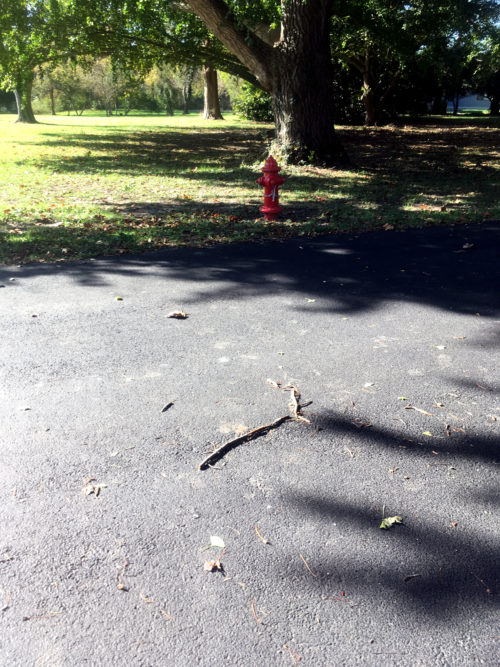Snake Encounters of the Third Kind
Kate Petersen ·I’m new to IAN, Horn Point Laboratory, and the East Coast. I came here from the west. The other day my co-worker, Emily, and I took a break to walk around outside a bit. She was telling me a little about what folks do here on campus, which includes “recycling” oyster shells. I didn’t ask follow-up questions and thought she meant that you could take oyster shells and put a new oyster baby in them and the baby would grow up and use those shells as its own shells. I would later learn that I had misunderstood and that I am oyster ignorant.* But at the time, I thought it seemed like cheating. But then I was like “cheating what … or whom?” God? Other oysters?
I had not yet completed my moral inventory when Emily and I happened upon a strange formation in the black top. A weird ripple.
It was a snake.
Deep monotone, chrome black. Matte black. Distinguishable from the asphalt driveway only upon deliberate inspection. It was absolutely still, positioned in a strangely regular, frozen undulation, like the graph of a sine wave. It didn’t seem like a living being. It seemed like it had been drawn there by math.
“Is it a rat snake?” Emily half asked, half observed. I pointed out that its head was not triangular like a viper, offering some supporting evidence to her hypothesis. I felt proud of myself for remembering the triangle viper head fact from my favorite childhood Zoobooks magazine issue, “Snakes.”
It was then that the snake began to expand. There is no other way to describe it. It was like when you drip water on a desiccated sponge. The snake’s strange algorithm curves disappeared. It got taller. Even though it’s a snake. This change revealed a white belly. As it got longer and wider, a subdued but distinct diamond pattern emerged on its scales. It was hard to understand what we were seeing. Could a snake be a chameleon? Why had I never heard of that? Also, I still wasn’t totally over the whole “you can grow a new oyster inside an old oyster” thing.
Then its head was a triangle. Like a viper. It raised up and contorted the front of its body, striking a classic angry rattlesnake pose. Emily and I were both backing away. The snake started slithering as well. But it wasn’t retreating. It was moving kind of sideways to us. There was a fire hydrant. I think the snake saw it before we did. The snake climbed the fire hydrant. It seemed like it wanted to get high enough to look us in the eyes. When it reached the hydrant apex, it reengaged its rattlesnake pose. Like “Your move.” Our move was to leave.
What was going on here? Can a snake become a super snake? Why is its head a triangle now? We went back to the office, where I Googled “Maryland snake changes shape, climbs fire hydrant.”
Our snake was a black rat snake, Pantherophis alleghaniensis. At least it was a dead ringer once it had achieved its final form.

Pantherophis alleghaniensis is apparently an excellent climber. They’re said to be “shy” and will allegedly “freeze” when they feel threatened, but they are also known to strike the rattlesnake pose (pun!). They are non-venomous, but can change the shape of their head, presumably to appear more viper-like. A fun fact: They also “brumate,” which is similar to hibernating, but involves different metabolic pathways that allow low-level physical activity such as drinking water. I couldn’t find any explanation for the pattern on its body seeming to change or why it was shaped like a Schrödinger equation.
Emily had gotten some pictures, but I decided to go back out with my camera to get more. As I approached the fire hydrant area, I saw our snake frenemy back in the driveway. And I saw a FedEx truck driving toward it.
Oh no.
I started running. I yelled even though I knew the driver couldn’t hear me. There were tears in my eyes and I was getting winded too fast. I wasn’t going to make it in time ….
But somehow the driver saw me and stopped. I ran the rest of the way to my new friend, only a meter shy of being crushed.
It was a stick.

I looked up at the fire hydrant. The snake was gone. The FedEx truck drove away. I wiped my eyes.
Godspeed you, black rat snake.

*I’ve since looked into oyster shell recycling and learned that it’s a cool way of redirecting ecological resources back into the Chesapeake Bay, as part of a widespread effort to support oyster population recovery. Oyster shells can be used to rebuild oyster reefs and create attachment surfaces for larval oysters (who then build their own shells). Oysters help clean Bay waters by filtering out sediments and nutrients. Oyster reefs can also mitigate storm damage by absorbing wave energy and preventing erosion.

